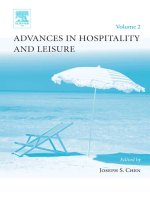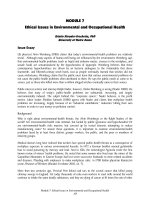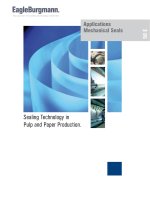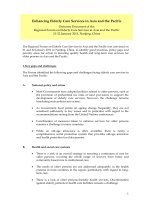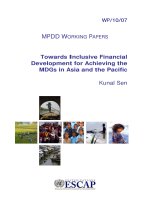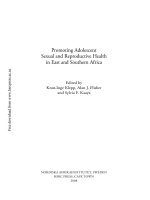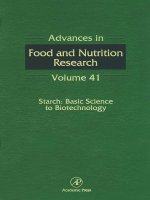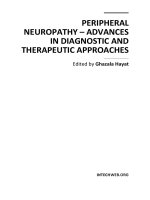PESTICIDES – ADVANCES IN CHEMICAL AND BOTANICAL PESTICIDES pptx
Bạn đang xem bản rút gọn của tài liệu. Xem và tải ngay bản đầy đủ của tài liệu tại đây (16.08 MB, 392 trang )
PESTICIDES – ADVANCES IN
CHEMICAL AND BOTANICAL
PESTICIDES
Edited by R.P. Soundararajan
Pesticides – Advances in Chemical and Botanical Pesticides
Edited by R.P. Soundararajan
Contributors
Malaya Ranjan Mahananda, Bidut Prava Mohanty, María Inés Maitre, Alba Rut Rodríguez,
Carolina Elisabet Masin, Tamara Ricardo, Erin N. Wakeling, April P. Neal, William D. Atchison,
Ahmed S. Abdel-Aty, Svetlana Hrouzková, Eva Matisová, Raymond A. Cloyd, Binata Nayak,
Shantanu Bhattacharyya, Jayanta K. Sahu, Dipsikha Bora, Bulbuli Khanikor, Hiren Gogoi, Simon
Koma Okwute, Rosdiyani Massaguni, Siti Noor Hajjar Md Latip, Annick Tahiri, Jackie Stevens,
Kerry Dunse, Jennifer Fox, Shelley Evans, Marilyn Anderson, Tatiana Baidyk, Oleksandr
Makeyev, Ernst Kussul, Marco Antonio Rodríguez Flores, Rafael Vargas-Bernal, Esmeralda
Rodríguez-Miranda, Gabriel Herrera-Pérez, Nédia de Castilhos Ghisi
Published by InTech
Janeza Trdine 9, 51000 Rijeka, Croatia
Copyright © 2012 InTech
All chapters are Open Access distributed under the Creative Commons Attribution 3.0 license,
which allows users to download, copy and build upon published articles even for commercial
purposes, as long as the author and publisher are properly credited, which ensures maximum
dissemination and a wider impact of our publications. After this work has been published by
InTech, authors have the right to republish it, in whole or part, in any publication of which they
are the author, and to make other personal use of the work. Any republication, referencing or
personal use of the work must explicitly identify the original source.
Notice
Statements and opinions expressed in the chapters are these of the individual contributors and
not necessarily those of the editors or publisher. No responsibility is accepted for the accuracy
of information contained in the published chapters. The publisher assumes no responsibility for
any damage or injury to persons or property arising out of the use of any materials,
instructions, methods or ideas contained in the book.
Publishing Process Manager Silvia Vlase
Typesetting InTech Prepress, Novi Sad
Cover InTech Design Team
First published July, 2012
Printed in Croatia
A free online edition of this book is available at www.intechopen.com
Additional hard copies can be obtained from
Pesticides – Advances in Chemical and Botanical Pesticides, Edited by R.P. Soundararajan
p. cm.
ISBN 978-953-51-0680-7
Contents
Preface IX
Section 1 Pesticide Toxicity 1
Chapter 1 Toxicity on Biochemical and Hematological
Parameters in Bufo melanostictus (Schneider)
(Common Indian Toad) Exposed to Malathion 3
Malaya Ranjan Mahananda and Bidut Prava Mohanty
Chapter 2 Evaluation of Earthworms Present on Natural and
Agricultural-Livestock Soils of the Center Northern
Litoral Santafesino, República Argentina 13
María Inés Maitre, Alba Rut Rodríguez,
Carolina Elisabet Masin and Tamara Ricardo
Chapter 3 Pyrethroids and Their Effects on Ion Channels 39
Erin N. Wakeling, April P. Neal and William D. Atchison
Chapter 4 Non-Traditional Pesticidally Active Compounds 67
Ahmed S. Abdel-Aty
Chapter 5 Endocrine Disrupting Pesticides 99
Svetlana Hrouzková and Eva Matisová
Chapter 6 Indirect Effects of Pesticides on Natural Enemies 127
Raymond A. Cloyd
Chapter 7 Photosynthetic Response
of Two Rice Field Cyanobacteria to Pesticides 151
Binata Nayak, Shantanu Bhattacharyya and Jayanta K. Sahu
Section 2 Botanical Pesticides and Pest Management 169
Chapter 8 Plant Based Pesticides: Green Environment
with Special Reference to Silk Worms 171
Dipsikha Bora, Bulbuli Khanikor and Hiren Gogoi
VI Contents
Chapter 9 Plants as Potential Sources of Pesticidal Agents:
A Review 207
Simon Koma Okwute
Chapter 10 Neem Crude Extract as Potential Biopesticide for Controlling
Golden Apple Snail, Pomacea canaliculata 233
Rosdiyani Massaguni and Siti Noor Hajjar Md Latip
Chapter 11 Evaluation of Combretum micranthum G. Don
(Combretaceae) as a Biopesticide Against Pest Termite 255
Annick Tahiri
Chapter 12 Biotechnological Approaches for
the Control of Insect Pests in Crop Plants 269
Jackie Stevens, Kerry Dunse, Jennifer Fox,
Shelley Evans and Marilyn Anderson
Chapter 13 Limited Receptive Area
Neural Classifier for Larvae Recognition 309
Tatiana Baidyk, Oleksandr Makeyev,
Ernst Kussul and Marco Antonio Rodríguez Flores
Section 3 Biomarkers in Pesticide Assay 327
Chapter 14 Evolution and Expectations of
Enzymatic Biosensors for Pesticides 329
Rafael Vargas-Bernal, Esmeralda Rodríguez-Miranda
and Gabriel Herrera-Pérez
Chapter 15 Relationship Between Biomarkers
and Pesticide Exposure in Fishes: A Review 357
Nédia de Castilhos Ghisi
Preface
Since the synthesis of DDT during 1874 several insecticide molecules have been
identified and synthesized globally for the control of insect pests, pathogens, microbes,
vectors of human and animal diseases, weeds and other obnoxious organisms.
Currently, 1.8 billion kgs of pesticides are used annually worldwide in the form of
herbicides, insecticides and fungicides. There are more than 1055 active ingredients
registered as pesticides till date implying that there is no best alternate for the
chemical pesticide. Pesticides are credited to save millions of lives by controlling
diseases, such as malaria and yellow fever, which are insect-borne. However, pesticide
exposure causes variety of adverse health effects and environmental pollution.
Alternate methods and restricted use of pesticide can minimize the risk of pesticide
usage. In agricultural pest management the use of plant based products and research
works on identification of toxic principles in the plant parts are worthwhile.
This book volume comprises of three different sections of which first section is on
Pesticide Toxicity with seven chapters. The section covers the mode of action of
pyrethroid group compounds, toxic effects of malathion on Indian toads and status of
farmers’ friend ‘earthworm’ in soils of natural and agriculture-livestock fields. In
addition, the toxicity of pesticides on cyanobacteria and natural enemies, some of non-
traditional pesticide compounds are also elaborately described. The second section of
the volume deals with botanical pesticides and pest management in six chapters.
Recently the pest management packages for agricultural and horticultural crops are
formulated with non-chemical approach by including botanical and microbial
pesticides. Biotechnological and molecular approaches are recent advancement in pest
management. This section is mainly focused on plants and plant products having
pesticidal principles and biotechnological approaches for insect pest management. An
interesting technique of LIRA to recognize insect larval density in the field as forecast
for applying pesticide and other management tactics is also included in this section.
The third section deals with biomarkers in the pesticide assay in two chapters.
Recently biomarkers are used for pesticide assays. Biosensors are innovative
components used to determine quantitative and qualitative parameters of pesticide
compounds and the detection is fast, reliable and with high portability.
I hope that this volume comprising the current status of pesticides with relevance to
pesticide toxicity, non-chemical pest management strategies and scope for biomarkers
X Preface
for pesticides assays will provide a significant insight to the scientists involved in
pesticide research. I appreciate all the authors for their valuable contribution.
I am indebted to Professor K.Gunathilagaraj, Tamil Nadu Agricultural University,
India for his inspiration and eminent guidance to hone my skills in editing. I
acknowledge Dr. N. Chitra my wife, for her support and encouragement during the
book chapters review process.
My special appreciation and thanks to the editorial team of InTech Publishing Co. for
their promptness, encouragement and patience during the publication process.
R.P. Soundararajan
Assistant Professor (Agricultural Entomology)
National Pulses Research Centre
Tamil Nadu Agricultural University
Tamil Nadu
India
Section 1
Pesticide Toxicity
Chapter 1
Toxicity on Biochemical and Hematological
Parameters in Bufo melanostictus (Schneider)
(Common Indian Toad) Exposed to Malathion
Malaya Ranjan Mahananda and Bidut Prava Mohanty
Additional information is available at the end of the chapter
1. Introduction
The widespread application of pesticides has attracted the attention of ecologists to under-
stand the impact of the chemical on natural communities have a large number of laboratory-
based single species studies of pesticide, such studies can only examine direct effect. How-
ever in natural communities, species can experience both direct and indirect effect. Anthro-
pogenic chemicals are pervasive in nature and biologists are faced with challenge of under-
standing how these chemical impact ecological community. A diversity of pesticides and
their residues are present in a wide variety of aquatic habitats [1,2,3]. While pesticides have
the potential to affect many aquatic taxa, the impacts on amphibians are of particular con-
cern in the past decade because of the apparent global decline of many species [4,5,6]. The
lists of possible causes of amphibian declines are numerous and pesticides have been impli-
cated in at least some of these declines. Pesticides occur in amphibian habitats [7,2], amphib-
ians living with insecticides in these habitats exhibit physiological signatures of these pesti-
cides and declining population are correlated with greater amounts of upwind agriculture
where pesticide use is common. While these correlative studies suggest that pesticides may
affect amphibian communities, there are few rigorous experiments to confirm that pesticides
are altering amphibian communities.
The widespread application of pesticides has attracted the attention of ecologists that strug-
gle to understand the impact of the chemical on natural communities have a large number
of laboratory-based single species studies of pesticides, such studies can only examine direct
effect. However in natural communities, species can experience both direct and indirect
effects.
World wide amphibian diversity and population numbers have been reported to be
declining [8,9,10]. Pesticides are sometimes implicated yet few studies have been conducted
Pesticides – Advances in Chemical and Botanical Pesticides
4
to determine if pesticides actually present a hazard to them [11]. In addition, most published
studies on the effects of pesticides on amphibians have been conducted on embryo and
tadpole life stages [12,13,14,15,16]. Only one study has been conducted on the effects of
malathion (diethyl mercaptosuccinate, S-ester with O, O-dimethyl phophorodithioate) on
amphibians in a post-metamorphic life stage. Two woodland salamander species
(Plethodonglutinosusand P. cinereus) to substrates which malathion had been applied to.
Plethodonglutinosusshowed significant inhibition of cholinesterase activity after 3 days of
exposure to a 5.6 kg/ha application of malathion.[17].Plethodoncinereusdid not show this
effect, thus indicating variations in speciessusceptibility to malathion. In the 1980’s,
malathion was applied annually to 4,486,000 ha in the United States [18]. It is used most
commonly in the control of mosquitoes, flies, household insects, animal ectoparasites, and
human lice. Malathion has been element labeled and applied to fields to study its potential
translocation and bioaccumulation; and small rodents, insects and birds had detectable
levels 1 yr after treatment [19].Malathion is lipophilic and readily taken up through the skin,
respiratory system, or gastrointestinal tract, with absorption enhanced if malathion is in the
liquid form [20]. The predominant mechanism of organophosphate toxicity is inhibition of
acetylcholinesterase in thenervous system causing accumulation of acetylcholine [21]. This
causes hyper excitability and multiple postsynaptic impulses generated by single
presynaptic stimuli. Minimal work has been conducted on effects of organophosphorus
compounds on disease susceptibility. At intraperitoneally injected doses above 230 mg/kg
the mice showed chromosomal abnormalities at 6 hr post-injection [22].Humans
occupationally exposed to organophosphorus compounds, including malathion, have
marked impairmentof neutrophil chemotaxis.[23] In addition, these workers had increased
frequency of upper respiratory infections which increased with the number of years of
exposure to organophosphorus compounds. Organophosphorus compounds can also affect
immune function of macrophages and lymphocytes in culture [24,25].
The main objectives of the present investigation is to find out the toxic effect of malathion on
total protein, total lipid and total carbohydrate content in brain and liver of Bufomelanos-
tictusas well as to observe the changes in hematological parameters in Indian Toad exposed
to Malathion.
2. Materials and methods
Both male and female toads (B. melanostictus) of various size (male body weight ranging from
21-65 gm and female body weight ranging from 13-100 gm) were collected during night time
and the test samples were brought into the laboratory and immediately transferred to the glass
container supplemented with mud and sand to provide a natural habitat to the Indian toad.
The samples were feed with liver and earthworm along with adequate water. The samples
were maintained at room temperature for a period of seven days for acclimation to the
laboratory condition and then used for experimentation in the eighth day.
To study the effect of Malathion, ten toads were placed in each glass container irrespective of sex
and size and sorted out in to two groups of each experiment i.e., one set is for control (without
Toxicity on Biochemical and Hematological Parameters
in Bufo melanostictus (Schneider) (Common Indian Toad) Exposed to Malathion
5
Malathion) and another is for experiment (with Malathion). One ml of Malathion in
concentrations of 25 ppm and 50 ppm (in acetone as solvent) each were injected subcutaneously
in the abdominal region of the Test samples species with the help of an insulin syringe.
After which thesamples were sacrificed by pitching and both liver and brain tissue were
dissected out to estimate the protein, lipid and carbohydrate content. The blood was collect-
ed to estimate the Hb, WBCs and RBCs in both experimental set and control set.Total pro-
tein, [26], Lipid [27] and Carbohydrate [28] contents were estimated in the Brain and liver of
Bufomelanostictus at 24 h, 48h, 72 hr and 96 hrs post-treatment with the test chemical.
Sahli’shaemoglobinometer was used to estimate of haemoglobin RBC count was done by
Neubaurs improved double haemocytometer using Hayem’s solution as diluting fluid
whereas for WBC count instead of Hayem’s solution, Turk’s fluid (W.B.C. diluting fluid)
was used. A batch of untreated (control) sample was also kept for comparison purposes.
The data obtained were analysed by using SPSS 10.0 package (SPSS INC, USA) and Two-
way ANOVA test was applied to find out the significant difference between the exposure
period and concentrations.
3. Results
Total protein content
InMalathion-treated samples after 24h exposure the reduction in protein content in liver was
found to be 22.22% and 30.55%. In the Braintissue the reduction was 75% and 44% in the
malathion-treated samples atconcentrations of 25 and 50 ppm respectively. At 48 hour of
exposure the reduction in protein content was 31.42% and 40% in liver where as in brain the
reduction was 73.33% and 80%. Similarly during 72 hour of exposure the reduction in pro-
tein content was 34.28% and 42.85% in liver whereas in brain the reduction was 82.35%.
During 96 h duration the reductions in protein content in the liver were recorded as 42.85 %
and 48.57%. In brain the decrease was 82.35% and 88.23% in the treated samples at the de-
sired concentrations of malathion respectively (Table 1).
Exposure
Duration in hour
Control 25 ppm 50ppm
Liver Brain Liver Brain Liver Brain
24 0.36±0.021 0.18±0.008 0.28±0.016
(22.22%)
0.05±0.021
(72.22%)
0.25±0.014
(30.55%)
0.04±0.014
(77.77%)
48 0.35±0.014 0.15±0.008 0.24±0.014
(31.42%)
0.04±0.08
(73.33%)
0.21±0.016
(40%)
0.03±0.024
(80%)
72 0.35±0.014 0.17±0.021 0.23±0.016
(34.28%)
0.03±0.094
(82.35%)
0.20±0.014
(42.85%)
0.03±0.007
(82.35%)
96 0.35±0.021 0.17±0.021 0.20±0.014
(42.85%)
0.03±0.014
(82.35%)
0.18±0.014
(48.57%)
0.02±0.008
(88.23%)
Table 1. Shows the protein content in both liver and brain tissue in B. melanostictus exposed to 25 ppm
and 50 ppm of malathion. The data in parentheses reflects the percent decrease over control in the
protein content
Pesticides – Advances in Chemical and Botanical Pesticides
6
Subjected to two way ANOVA a significant difference was observed between the exposure
period (F
1 0.05 = 6.02) as well as between the concentrations (F2 0.05 = 92.46) in case of liver
tissues whereas a non significant difference was observed between the exposure period (F
1
0.05
= 2.96) in brain tissue. However, between concentration significant difference was
observed (F
2 0.05 = 374.22)
Total lipid content
Total lipid content was estimated in the liver and brain of the treated organisms. After 25
ppm and 50 ppm of Malathion treatment, for 24 h the lipid content was found to be
56.36% and 61.81% in Malathion treated liver respectively. In the brain of Malathion
treated toad the reduction was 64% and 68 % respectively. At 48 h exposure the decrease
in lipid content in liver was 58.18% and 63.63% where as in brain it was 65.21% and
69.56%. Simultaneously, during 72 h of treatment the percent reduction in total lipid
content in Malathion treated liver was 60% and 65.45% and in brain 66.66% and 75% was
observed respectively. At 96 hour of treatment with 25 ppm and 50 ppm of Malathion
the lipid content was found to be 61.81% and 65.45% respectively. In case of Malathion
treated brain of the test samples the reduction was found to be 69.56% and 78.26% (Table
2). Subjected to two way ANOVA test a non significant difference was observed between
the exposure duration (F
1 0.05 = 3.47) where as between the concentrations significant dif-
ference was noticed (F
2 0.01 = 3256.06) in case of liver tissue. Simultaneously the data ob-
tained from the treated brain a significant difference was found between exposure period
and the concentrations. (F1 0.05 = 11 and F2 0.01 = 1461).
Exposure
Duration in hour
Control 25 ppm 50ppm
Liver Brain Liver Brain Liver Brain
24 55±0.81 25±1.42 24±1.41
(56.36%)
9±1.63
(64%)
21±1.41
(61.81%)
8±1.41
(68%)
48 55±0.41 23±0.81 23±2.82
(58.18%)
8±1.41
(65.21%)
20±1.41
(63.63%)
7±1.42
(69.56%)
72 55±0.71 24±0.82 22±0.81
(60%)
8±1.63
(66.66%)
19±1.41
(65.45%)
6±0.81
(75%)
96 55±1.63 23±0.85 21±0.021
(61.81%)
7±1.63
(69.56%)
19±1.41
(65.45%)
8±0.81
(78.26%)
Table 2. Reflect the Lipid content in both liver and brain tissue in B. melanostictusexposed to 25 ppm
and 50 ppm of malathion. The data in parentheses reflects the percent decrease over control in the Lipid
content.
Total carbohydrate content
In this present experiment, when the toads were exposed to the desired concentrations of
the test chemical for different time interval a drastic reduction in total carbohydrate
content in liver as well as in brain tissue was observed. After 25 ppm and 50 ppm of
Toxicity on Biochemical and Hematological Parameters
in Bufo melanostictus (Schneider) (Common Indian Toad) Exposed to Malathion
7
Malathion treatment, for 24 h the carbohydrate content was found to be 45.58% and
54.41% in liver tissue respectively. In the brain tissue the reduction was 55.28% and 57.14
% respectively. At 48 h exposure the decrease in carbohydrate content in liver was 53.96%
and 57.14% where as in brain it was 60.52% and 63.15%. Simultaneously, during 72 h of
treatment the percent reduction in total carbohydrate content in liver was 60% and 61.53%
and in brain 60.6% and 63.63% was observed respectively. At 96 hour the carbohydrate
content in both liver and brain was found to be 60.93%, 64.06% and 66.66% respectively in
both the concentrations (Table 3). When the data obtained in case of liver and were
analyzed by two way ANOVA test a significant difference was observed between the
exposure duration (F
1 0.05 = 11.67) and between the concentrations (F2 0.01 = 939.50).
Whereas, the data obtained from the treated brain non significant difference was found
between exposure periods (F
1 0.05 = 1.37) however, a significant difference was noticed
between the concentrations F
2 0.01 = 781.25).
Exposure
Duration in hour
Control 25 ppm 50ppm
Liver Brain Liver Brain Liver Brain
24 0.68±0.008 0.35±0.008 0.33±0.036
(45.58%)
0.16±0.021
(55.28%)
0.31±0.021
(54.41%)
0.15±0.014
(57.14%)
48 0.63±0.016 0.38±0.008 0.29±0.012
(53.96%)
0.15±0.008
(60.52%)
0.27±0.016
(57.14%)
0.14±0.014
(63.15%)
72 0.65±0.016 0.33±0.016 0.26±0.021
(60%)
0.13±0.094
(60.60%)
0.25±0.021
(61.53%)
0.12±0.008
(63.63%)
96 0.64±0.008 0.36±0.016 0.26±0.021
(60.93%)
0.12±0.014
(66.66%)
0.23±0.016
(64.06%)
0.12±0.008
(66.66%)
Table 3. Reflect the Carbohydrate content in both liver and brain tissue in B. melanostictus exposed to 25
ppm and 50 ppm of malathion. The data in parentheses reflects the percent decrease over control in the
carbohydrate content
Hemoglobin content
After treatment with 25 ppm and 50 ppm of Malathion in different time interval the bloods
from the test samples were collected and hemoglobin was measured. From the result it was
observed that during 24 hr of exposure the percent reduction in hemoglobin content was
26% and 6.57 %. At 48 hr of treatment the percent reduction in hemoglobin in malathion
treated blood was found to be 7.89% and 9.21%. After 72 hour of exposure a reduction of
7.89% and 10.52% in the hemoglobin content was observed for 25 ppm and 50 ppm
concentration respectively. A decrease of 8% and 10.66 % was found after 96 hour of
exposure (Table 4).
When the data were subjected to two-way ANOVA a significant difference was observed
between the exposure periods (F
1 0.05 = 6.55) as well as between the concentrations (F2 0.05 =
97.80)
Pesticides – Advances in Chemical and Botanical Pesticides
8
Exposure
Duration in
hour
Control 25 ppm 50ppm
Hb WBC RBC Hb WBC RBC Hb WBC RBC
24 7.6±0.081 4.96±0.94 7.65±0.47 7.2±0.16
(5.26%)
4.76±0.47
(4.03%)
7.55±1.69
(1.30%)
7.1±0.16
(6.57%)
4.28±0.94
(13.70%)
7.54±1.88
(1.43%)
48 7.6±0.081 4.96±1.69 7.64±0.94 7±0.16
(7.89%)
4.68±1.88
(5.64%)
7.54±1.88
(1.30%)
6.9±0.14
(9.21%)
4.22±0.47
(14.91%)
7.43±0.47
(2.74%)
72 7.6±0.21 4.96±0.94 7.63±1.69 7±0.14
(7.89%)
4.42±0.94
(10.88%)
7.38±0.94
(3.27%)
6.8±0.21
(10.52%)
4.09±0.47
(18.54%)
7.29±0.47
(4.45%)
96 7.5±0.081 4.96±0.94 7.62±2.49 6.9±0.14
(8%)
4.09±0.47
(17.54%)
7.15±1.69
(6.16%)
6.7±0.17
(10.66%)
3.84±0.47
(22.58%)
7.08±0.47
(7.08%)
Table 4. Reflects the Hb, WBC and RBC content in B. melanostictusexposed to 25 ppm and 50 ppm of
malathion. The data in parentheses reflects the percent decrease over control in the Heamatological
parameters.
WBC Content
From the experiment it was observed that the WBC content of B.melanostictuswas also re-
duced drastically. After 24 hr of exposure to 25 ppm and 50 ppm of malathion the decrease
in the WBC was found to be 4.03% and 13.70%. Similarly at 48 hr a drastic reduction of
5.64% and 14.91% in the WBC content of toad was found at 25 ppm and 50 ppm of malathi-
on concentration. At 72 hour the percent inhibition of 10.88% and 18.54% was recorded
respectively and after 96 hour of exposure to the desired concentrations of the test chemical
the reduction in WBC content was found to be 17.54 % and 22.58%.
Subjected to two-way ANOVA, non-significant difference was observed between the
exposure periods (F
1 0.05 = 2.88) whereas between concentrations a significant difference was
observed (F
2 0.05 = 31.43).
RBC Content
From the experiment it was observed that the RBC content of B.melanostictuswas also
reduced drastically like that of WBC content. After 24 hr of exposure to 25 ppm and 50 ppm
of malathion the decrease in the RBC was found to be 1.30% and 1.43%. Similarly at 48 hr a
drastic reduction of 1.30% and 2.79% in the RBC content of toad was found at 25 ppm and
50 ppm of malathion concentration. At 72 hour the percent inhibition of 3.27% and 4.42%
was recorded respectively and after 96 hour of exposure to the desired concentrations of the
test chemical the reduction in RBC content was found to be 6.10 % and 7.08%.
Subjected to two-way ANOVA, non-significant difference was observed between the
exposure periods (F
1 0.05 = 4.68) whereas between concentrations a significant difference was
observed (F2 0.05 = 8.83).
4. Discussion
The organophosphates are compounds widely used as insecticides and chemical welfare
agents. Although extremely toxic in some cases, these materials are generally short lived in
Toxicity on Biochemical and Hematological Parameters
in Bufo melanostictus (Schneider) (Common Indian Toad) Exposed to Malathion
9
the environment compared to halogenated organics and related compounds. The toxicity of
an organophosphate is related to its leaving group, the double bonded atom, usually O or S
and the phosphorous ligands, the groups surrounding the phosphate in the compound. The
metabolic replacement of sulphur by oxygen in the liver or other detoxicification organ
activates the sulphur containing organophosphate into a much more potent form. The
extreme toxicity of these compounds is due to their ability to bind to the amino acid serine,
rendering it in capable of participating in a catalytic reaction within enzyme as the further
blocking of the active site by the organophosphate residue.
The decrease of total protein content in both liver and brain is may be due to less
incorporation of amino acids in the translation process i.e., a reduced incorporation into any
kind of proteins and pesticides disturb the protein synthesis. In the present study the total
protein content in both liver and brain in Indian Toad decreased after malathion (25 ppm
and 50 ppm) treatment.
The reduction in total protein contents after pesticide application in different insects was
reported by many workers. See [29, 30, 31, 32, 33, 34, 35].The protein reduction the liver and
kidney of reptiles was also reported [36,37]. The present investigations also appear to be in
line with the earlier findings. The present results therefore confirm the findingsin this
respect.
Carbohydrates are less sensitive as compared to lipids. A reduction in the glycogen
concentration in the treated groups could have happened due to activation of glycogenolytic
enzymes like phosphorylase system leading to decrease in glucose concentration by
malathion in the liver tissues of treated animals. The treated animals being under malathion
stress, the stress hormone (epinephrine) released from the adrenal medulla possibly have
acted on the liver tissues vide circulation leading to glycogenesis, mediated by
adenylatecyclase, cAMP, protein kinase and finally the activated phosphorylase system.
From this present investigation it was observed that, malathion has a strong potential to
reduce the carbohydrate content in liver and brain tissue of treated toad.
In the current study, the decreased total lipid content may possibly due to either decreased
lipogenesis or suppressed translocation/transportation of lipid to plasma. The effect of the
doses of whole body treated seems to have acted in same way to depress lipogenolysis pos-
sibly by denaturing or by inactivating some of the lytic enzymes, or by hampering the
transportation of these molecules to other steroidonesis tissues via the plasma pool due to
alternation in membrane functions. Therefore the enhanced level of cholesterol concentra-
tion may have contributed to an overall decrease in the total lipid pool of the liver tissue of
the treated animals.
The stress induced changes in the total leucocytes count and differential count in mammals
have been reported [38,39]. The release of granulocytes from bone marrow as a result of
stress induced stimulation mediated by corticosteroids a stress hormone may be the
possibility [40]. The lymphocytes which constitute the dominant leucocytes type in toads
appear to decrease. Such as decrease in the lymphocytes count may either be due to rupture
or degradation of some of these aged circulating immuno competent cells.
Pesticides – Advances in Chemical and Botanical Pesticides
10
The heamolysis of Red blood cells have been reported in various physical and chemical
stress [41,42] Under such condition the total circulation red cell population is expected to
show a decline in number. The observed decrease in the circulating red cell count can be
accounted for the possible mechanisms such as decrease production of renal erythropoietin
which stimulates the bone marrow and spleen to release more erythrocytes. From this
experiment it was observed that malathion has a strong potential to reduce hemoglobin,
WBC and RBC in Bufomelanostictus.
Author details
Malaya Ranjan Mahananda and Bidut Prava Mohanty
Department of Environmental Sciences, Sambalpur University, Jyoti-Vihar, Burla, Orissa, India
5. References
[1] McConnell, L. L., J. S. Lenoir; S. Datta and J. N. Seiber (1998). Wet deposition of current
use pesticides in the sierro. Nevada mountain range California, USA. Environmental
Toxicology and Chemistry 17:1908-1916.
[2] Lenoir, J.S , T. M. Cahill, J. N. Sieber, L. L., McConnell and G. M. Fellers. (1999).
Summertime transport of Current use pestcides from the California Central Valley to
Sierra Nevada mountain Range, USA. Environmental toxicology and Chemistry. 18(12);
2715-2722
[3] Kolpin, D.W., Thurman, E. M. and Linhart, S. M. (2000). Finding minimal herbicide
concentrations in ground water? Try looking for their degradates. Sci. Tot. Environ. 248:
115-122.
[4] Blaustein, A. R. and D. B. Wake (1990). Declining amphibian population: a global
phenomenon? Trends in Ecology and Evolution 5.
[5] Alford, R. A., Richards, S. J. (1999). Global amphibian declines, V.10: 365.
[6] Keisecker (2001). The amphibian decline crisis. Biological Conservation. 3: 45.
[7] Harris, M. L., Bishop, C. A., Struger, J., Ripley B. and Bugart, J. P. (1998). The functional
integrity of northern leopard frog ( Ranapipiens )and green frog (Ranaclamitans)
population in orchard wetlands. II. Genetics. Physiology and biochemistry and of
breeding adults and young of the year. Environmental Toxicology and Chemistry. 17:
1338-1350.
[8] Wyman, R. L. 1990. What’s happening to amphibians?Conservation Biology 4: 350–352.
[9] Wake, D. B. 1992. Declining amphibian populations.Science 253: 860.
[10] Taylor, S. K., E. S. Williams, E. T. Thorne, K.W.Mills, D. I. Withers, and A. C. Pier. 1999.
Causes of mortality of the Wyoming toad. Journalof Wildlife Diseases 35: 49–57.
[11] Hall, R. J., and P. F. P. Henry. 1992. Review: Assessing effects of pesticides on
amphibians and reptiles: Status and needs. Herpetological Journal2: 65–71.
[12] Hall R. J. and E. Kolbe. 1980. Bioconcentration of organophosphorus pesticides to
hazardous levelsby amphibians. Journal of Toxicology and EnvironmentalHealth 6:
853–860.
Toxicity on Biochemical and Hematological Parameters
in Bufo melanostictus (Schneider) (Common Indian Toad) Exposed to Malathion
11
[13] DE Llamas, M. C., A. C. DE Castro, and A. M. Pechen DE D’Angelo. 1985.
Cholinesterase activities in developing amphibian embryos following exposure to the
insecticides dieldrin and malathion. Archives of Environmental Contamination and
Toxicology 14: 161–166.
[14] Devillers, J., and J. M. Exbrayat. 1992. Ecotoxicityof chemicals to amphibians. Antony
RoweLtd., London, UK, 339 pp.
[15] Rosenbaum, E. A., A. Caballero DE Castro, L. Gauna, and A. M. pechen DE D’Angelo.
1988. Early biochemical changes produced by malathion on toad embryos. Archives of
Environmental Contamination and Toxicology 17: 831– 835.
[16] Berrill, M., S. Bertram, L. M. Mcgillivray, M. Kolohon, and B. Pauli. 1994. Effects of low
concentration of forest-use pesticides on frogembryos and tadpoles. Environmental
Toxicologyand Chemistry 13: 657–664.
[17] Baker, K. N. 1985. Laboratory and field experiments on the responses by two species of
woodland salamandersto malathion treated substrates. Archives of Environmental
Contamination and Toxicology 14: 685–691.
[18] Smith, G. J. 1987. Pesticide use and toxicology inrelation to wildlife: Organophosphorus
and carbamatecompounds, Resource Publication 170.United States Department of the
Interior, Fishand Wildlife Service, Washington, D.C., 171 pp.
[19] Peterle, T. J. 1966. Contamination of the freshwaterecosystem by pesticides. In
Pesticides in the environmentand their effects on wildlife, N. W.Moore (ed.). Journal of
Applied Ecology, supplement3: 181–192.
[20] Gunther, F. A., W. E. Westlake, and P. S. Jaglan.1968. Reportedsolubilities of 738
pesticidechemicals in water. Residue Reviews 20: 1–148.
[21] Ecobichon, D. J. 1993. Toxic effects of pesticides.In Casarett and Doull’s Toxicology—
The basicscience of poisons, 4th Edition, M. O. Amdur, J.Doull, and C. D. Klaassen
(eds.). McGraw-Hill,Inc, New York, New York, pp. 565–622.
[22] Dulout, F. N., M. C. Pastori, and O. A. Oliver.1983. Malathion-induced chromosomal
aberrationsin bone marrow cells of mice: Dose-responserelationships. Mutation
Research 122:163–167.
[23] Hermanowicz, A., and S. Kossman. 1984. Neutrophil function and infectious disease in
workersoccupationally exposed to phospho-organic pesticides:Role of mononuclear-
derived chemotacticfactor for neutrophils. Clinical Immunologyand Immunopathy 33:
13–22.
[24] World Health Organization. 1986. Organophosphorusinsecticides: A
generalintroduction. EnvironmentalHealth Criteria 63. World HealthOrganization,
Geneva, Switzerland, 181 pp.
[25] Pruett, S. B. 1992. Immunotoxicity of organophosphoruscompounds. In
Organophosphates:Chemistry, fate, and effects, J. E. Chambers, andP. E. Levi (eds.).
Academic Press, San Diego,California, pp. 367–386.
[26] Lowry, O. H., Resebrought, N. J., Farr, A. L. and Randall, R. J. (1951). Protein
measurement with the Folin Phenol reagent. J. Biol. Chem. 193: 265-275.
[27] Folch, J. N., Less, M. P. and Solan-Stanles (1957). Lipid measurement by methanol and
choloform. J. Biol. Chem. 226: 497.
Pesticides – Advances in Chemical and Botanical Pesticides
12
[28] Samseifter, S, Dayton Novic, B and Edward, M. N. (1949). The estimation of glycogen
with the anthrone reagent. Federation Proc. 8: 249.
[29] Naqvi, S.N.H., Shafi, S. and Zia, N. 1986. Effect of diflubenzuron andpenfluron on the
protein pattern of Blattellagermanica. Pak. J.Entomol. Kar ., 1: 81-86.
[30] Javaid, M.A. 1989. Biochemical investigations on the effect ofazadirectin on the
development of Heliothisarmigera (Hub).M.Phil. Thesis, Quaid-e-Azam University,
Islamabad, 270 pp.
[31] Nizam, S. 1993. Effect of allelochemicals against 3rd instar larvae ofMuscadomestica L.
(Malir strain). Ph.D. thesis, University ofKarachi, 369 pp.
[32] Saleem, M.A., Shakoori, A.R. and Mantte, D. 1998. In vivo ripcordinduced
macromolecular abnormalities in Triboliumcastaneumlarvae. Pak. J. Zool., 30(3): 233-
243.
[33] Ahmad, I. Perveen, A., Khan, M.F., Akhater, K. and Azmi, M.A. 2000.Determination of
toxicity of early immature neem berries extractas compared to profenophos against
Triboliumcastaneum.Pakistan Zoological Congress (Ed., Shakoori, A.R), Vol. 20, pp.93-
100.
[34] Ahmad, I., Shamshad, A. and Tabassum, R. 2000. Effect of neemextract in comparison
with cypermethrin (10 EC) andmethylparathion (50 EC) on cholinesterase and total
proteincontent of adult Triboliumcastaneum(PARC strain). Bull. Pure &Appld. Sci.,
19A(1): 55-61.
[35] Tabassum, R. and Naqvi, S.N.H., Effect of dimilin (IGR), NC and Nfc(neem extracts) on
nucleic acid and protein contents ofCallosobruchusanalis (F) of 21st Pakistan Zoological
Congress(Ed., Shakoori, A.R) Inpress.
[36] Khan, M.Z. 2000. Determination of induced effect in Agama againstpermethrin and
neem fractions and their effect on proteinic andenzymatic pattern. Ph.D. thesis,
University of Karachi, 142 pp.
[37] Fatima, F. 2001. Bioecology of Calotesversiclor with special referenceto induce effect of
pyrethroid and organophosphate M.Phil thesis,University of Karachi, 147 pp.
[38] Madan Mohan, S. G., Surange, V. Srinivasan and U. C. Rai (1980). Effect of solar eclipse
on egg and leucocytes in albino rats, Ind. J. Exp. Biol. 18 (12):1492-1493.
[39] Sudaresan, G., N. Suthathirarajan and A. Namasivayam (1990). Certain immunological
parameters in subacute stress. Indian Journal of Physiology and Phramacology. 34:
1492-1493.
[40] Wright Samson (1966). Applied Physiology 11thedn. Revised by C. A. Keela and E.
Neil, p. 1-526, Oxford University Press, Publ. London.
[41] Coakley, W. T., A. J. Bater, L. A. Crum and J. O. T. Deeley (1979). Morphological
changes, hemolysis and micro vascularization of heated human erythrocytes. J. Therm.
Bio 4(1): 85-94.
[42] Safronov, V. A. and N. A. Maiorava (1978). Erythrocyte haemolysis in liquor, Probl.
Gematol. Pereliv. Kroivi 23(2): 56-61.
Chapter 2
Evaluation of Earthworms Present
on Natural and Agricultural-Livestock Soils
of the Center Northern Litoral Santafesino,
República Argentina
María Inés Maitre, Alba Rut Rodríguez,
Carolina Elisabet Masin and Tamara Ricardo
Additional information is available at the end of the chapter
1. Introduction
For a long time in Argentina, farmers had concentrated on a mixed system of livestock and
crops, mainly wheat and corn. Soybean was not a traditional crop [1].
During the 1990’s (20
th
century) the agricultural frontier reached a planted surface that rose
11.000.000ha with the adoption of technologies that includes transgenic seeds, limited tillage
and application of pesticides and fertilizers [2, 3]. The main crops are soybean monocultures
and soybean/wheat soybean double crops corn. This two crop sequences have different C
dynamics response to management such as tillage or fertilization [4]. In the 2000-2009’s
pesticide market had triplicate [5] being the most popular endosulfan, lambda-cyhalothrin,
cypermethrin, chlorpyrifos, metamidophos and the herbicides glyphosate, atrazine and 2,4D
[6]. Importance of edaphic fauna to the soil fertility is well known, especially with
oligochaeta that are being used as bioindicators of the soil health [7-13].
Earthworms spent their whole life cycle in the soil horizons and because of their feeding and
burrowing behaviour they directly or indirectly help to improve every physical, chemical
and biological process of the soil. Earthworms participate in the mixing of organic and
inorganic fractions of soil, formation of stable clusters, dynamic and recycling of nutrients
from the decomposition of organic matter, their burrows help to the aeration, infiltration
and drainage of soil
[14]. Earthworms represent over the 80% of the biomass invertebrate of
the soil, therefore they are an useful group to evaluate the effect of pesticides either on field
as on laboratory tests. The ecotoxicological impact of Argentina’s current production system
Pesticides – Advances in Chemical and Botanical Pesticides
14
is not well known and evaluated and requires the realization of deeper studies using fast
and reliable bioindicators in order to understand the biological processes related with the
anthropogenic alterations of the environment [15-28]. Therefore we performed
ecotoxicological bioassays under laboratory conditions and field evaluations of parameters
such as biomass, richness and density of earthworms.
2. Materials and methods
2.1. Field experiences
2.1.1. Study site description
In order to evaluate the influence of different production systems over the oligochaetofauna,
five sites from different areas of the north and centre of Santa Fe province were sampled
(Fig.1, Table 1).
Figure 1. Map of the sampling sites.
Evaluation of Earthworms Present on Natural and
Agricultural -Livestock Soils of the Center Northern Litoral Santafesino, República Argentina
15
1. Livestock in woodland (Ganadería en Monte Nativo: GMN) located in Naré, is a native
woodland, used for bovine livestock alternated with fallow periods. Characterized by
the presence of Prosopis nigra, Eucaliptus spp., Acacia acaven, Erythrina crista-galli,
Enterolobium contortisiliquum, Cynodon dactylon, Cynodon rotundus, Digitaria sanguinalis.
2. Fallow field (Lote en Descanso: LD) located in Sarmiento, used 3 years ago as paddock for
bovine livestock. At present without activities. Characterized by the presence of
Cynodon dactylon, Cirsium vulgare, Solanum sisymbriifolium, Digitaria sanguinalis, Melia
azedarach L.
3. Non Tillage (Agrícola con Siembra Directa: ASD) located in Isleta Norte, with over 30 years
of agricultural practices (last 15 years with minimum tillage). Crops consisted in
sunflower, soybean, corn and sorghum. Pesticides applied were glyphosate-
coadyuvants (4.5 l.ha
-1
), atrazine (3 l.ha
-1
) and superphosphate triple calcium fertilizer
(65 kg.ha
-1
).
4. Non Tillage with added organic amendments (Agrícola con Siembra Directa y Abono Orgánico:
ASDAO) located in Ocampo Norte, with over 20 years of agricultural practices with
minimum tillage. Crops consisted in soybean, sunflower, cotton, corn and oat. Synthetic
fertilizers superphosphate triple calcium (65 kg.ha
-1
) and organic fertilizers (cow dung),
glyphosate (4 l.ha
-1
) and clorimuron (60g.ha
-1
) are applied.
5. Livestock in grassland (Ganadería en Pastizal Natural: GPN) located in El Sombrerito, is a
natural grassland used for the feeding of ovine cattle, rotating with fallow periods.
Agrochemicals and mechanic weed control are not used. Vegetation consist of Erythrina
crista-galli, Enterolobium contortisiliquum, Brachiaria platyphilla, Digitaria sanguinalis,
Paspalum quadrifarium, Cynodon dactylon, Sorghum halepense, and others.
Sites
Geographical
Coordinates
Location
Year/ Season
South
Latitude
West
Longitude
1. Livestock in
woodland (GMN)
30º 53’
12.09’’
60º 27’
01.92’’
Naré (San Justo) 2009/Spring
2. Fallow field
(LD)
31° 04’
25,11”
61° 10’
32,30”
Sarmiento
(Las Colonias)
2011/Spring
3. Non tillage
(ASD)
28º 27’
34.18’’
59º 18’
57.17’’
Isleta Norte
(Gral. Obligado)
2011/Summer
4. Non tillage with
added organic
amendments
(ASDAO)
28º 27’
21.84’’
59º 22’
26.93’’
Ocampo Norte
(Gral. Obligado)
2011/ Summer
5. Livestock in
grassland (GPN)
28º 38’
00.43’’
59º 27’
59.79
El Sombrerito
(Gral. Obligado)
2011/ Summer
Table 1. Geographical coordinates of the sampling sites and sampling season.
